How-To: Corner Speed
Have you noticed that really fast guys don’t just accelerate and brake more effectively than everyone else; they also carry more speed the entire way around a turn? Riders often make the mistake of thinking that there’s a predetermined maximum speed that a given dirt bike with a given set of tyres can go around a long corner. Not true. Guys who are winning races routinely find a way to carry more speed through turns, and they seem to do it with smoother style and grace. Team Motorex KTM Off-Road rider, Toby Price, has an uncanny ability to carry lots of corner speed, no matter what sort of terrain he’s riding. So, just to prove you don’t need a race bike with factory suspension to do what he does, we asked Toby to take a standard 2012-model KTM 450EXC through a series of turns and articulate what he’s doing with his brakes, body weight, controls, vision and throttle application. Here’s what the two-time AORC, A4DE and Hattah winner had to say…
This content was originally published in issue #15 of Transmoto Dirt Bike Magazine in Dec, 2011.

Approach
Obviously, knowing a corner will help give you the confidence to attack it faster. Racers usually get the chance to pre-walk tests, but on the trail, you rarely get that opportunity. Which is exactly why it’s important to really focus on the approach to a turn. If there’s one mistake I see guys making, it’s not setting up early enough for a corner. If you come into a turn too hot and with the bike all out of shape, it’s difficult to settle the bike for the corner. That’ll then affect your speed down the next straight. So it’s a matter of giving up a little bit on the entry to make up more time through the turn and on the next section of track.
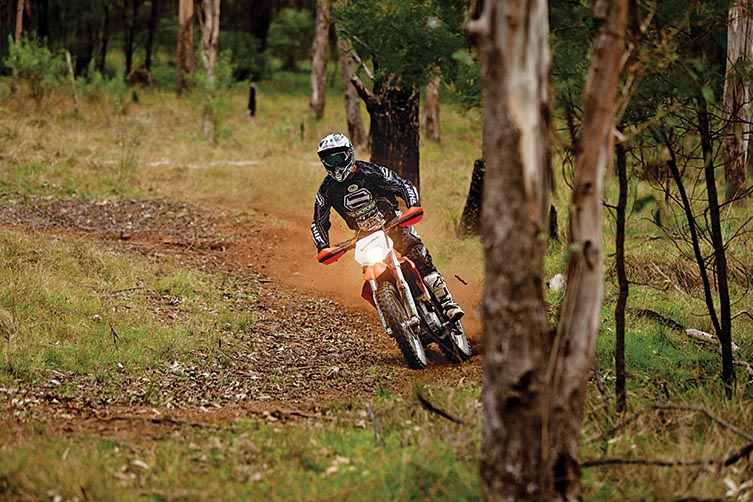
Vision
In open terrain when you can see around most of the corner, you can gauge what sort of mid-corner speed you’ll be able to carry. You need to choose your line and avoid the worst braking bumps for a smooth corner entry, but your vision should be through the turn, not just beyond your front guard. I try to look at least halfway around the corner and focus on where I want my front wheel to go. The further through the turn you’re able to scan, the longer you’ll have to anticipate things – like bumps that can unsettle the bike or terrain that you can use to turn off.
Settling the Bike
Most of your braking is done with the front brake, but it’s important to drag the rear into turns as this will help keep the bike’s rear-end more planted, which will set you up better for a fast, flowing corner. If you run all front brake, the rear-end can kick out and over the top of the rut/berm, or it can kick in, which will stand the bike up and make you blow through it. If the corner entry is chopped out, you may have to stand longer, but if it’s a smooth entry, it’s preferable to sit down earlier. Either way, the transition from a standing to seat position needs to be smooth to ensure the bike doesn’t become unsettled. In the opening spread, I’ve selected third gear before I sit down, because shifting mid-corner is going to upset the bike’s flow and the clean arc I want to draw around the turn.
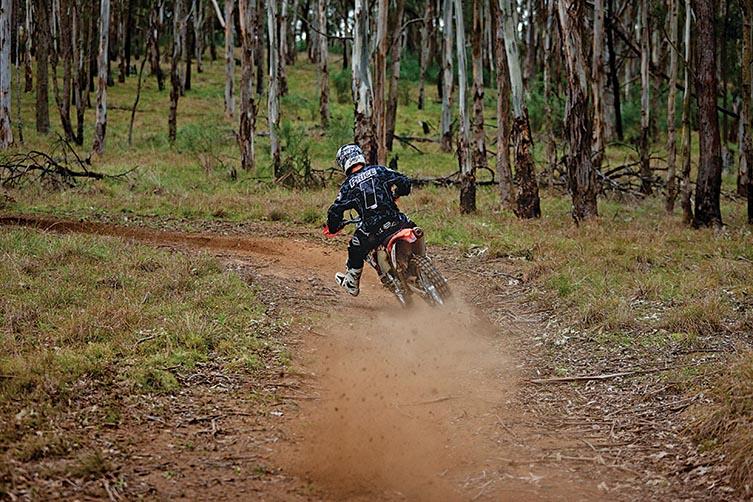
Line Selection
As always, looking ahead is the key. If there’s something to turn off right at the start of the corner, you’ll know you can come in a bit harder. But if the rut doesn’t form up until a little way into the turn, you may want to come in a bit straighter and then use that taller section of rut or berm to lay the bike over and initiate the turn. In the opening sequence, the rut forms early. Then there’s a flat mid-turn section, before it banks up again in the second part of the turn. So you can see that I’ve cranked in pretty hard, and then, where there’s not so much to turn off, I’ve stood the bike up and weighted the outside peg a little more for traction. Then I’ve laid it over further on the second apex. What you’re looking to do is get the wheels settled into the rut – especially from the apex all the way through to the exit – to ensure the best momentum.
Throttle Control
A lot of guys don’t pay enough attention to throttle control through a turn. And when they’re erratic with the throttle, the bike will get sideways and then stand up. And that’s what kills corner speed. You want to be in a gear that you can carry around the whole turn, and then roll the throttle on progressively. If you stab the throttle, you’ll light the rear wheel up or wheelstand when you don’t want to. You’ll find that if you set yourself up early for the corner, it’ll be much easier to apply the throttle smoothly. It might feel slow, but if you’re smooth with the throttle and draw a flowing line, it’s almost always faster.

Inside Leg
Rather than using your inside leg as a counter-balance, the idea is that your inside leg should be up near your front axle to weight the front wheel and give it maximum traction. Particularly on off-camber corners, I use my inside leg more than most guys as an insurance policy, in case the front-end wants to tuck when I’m pushing hard. On hardpack, and where there’s nothing to snag my boot, I point my toe and slide my heel along the ground, as it lets me react immediately to any front wheel washout. This gives me the confidence to push into a turn harder than I otherwise would, crank the bike over further, and carry more corner speed. Sliding your inside leg on the ground is more dangerous on tracks you don’t know well, as you can stab your boot into a tree root or rock. So you should always keep your knee slightly bent so there’s some give if your boot does suddenly snag something.
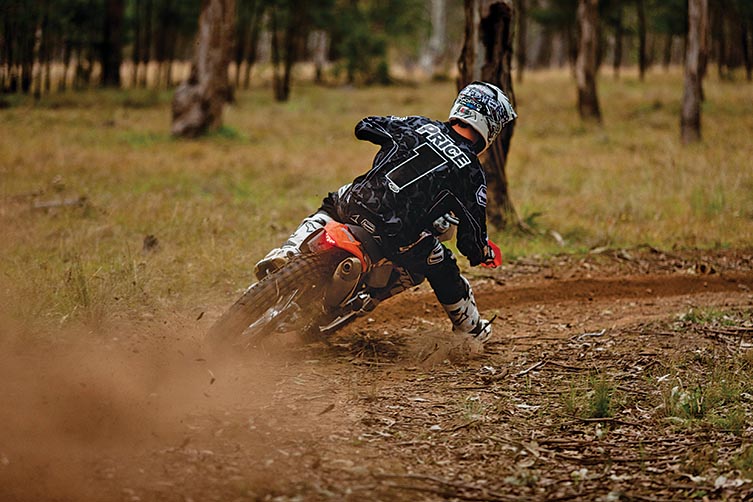
Using the Terrain
While your body can relax to some extent when you’re sitting down through a turn, your mind can’t! You need to be on the ball the whole time and always looking for terrain you can turn off. At the same time, you want to be scanning ahead for bumps or obstacles that can upset your corner speed, and then altering your line smoothly to avoid them. For example, if you’re halfway through a turn and see that the berm gets steeper five or 10 metres in front of you, you’ll know you can leave the power on a little longer and carry more speed into that portion of the turn, and be confident that it’s solid enough to turn off. It’s kind of like what rally drivers do – based on what their navigator is telling them is up ahead, they have the confidence to push harder than they normally would.
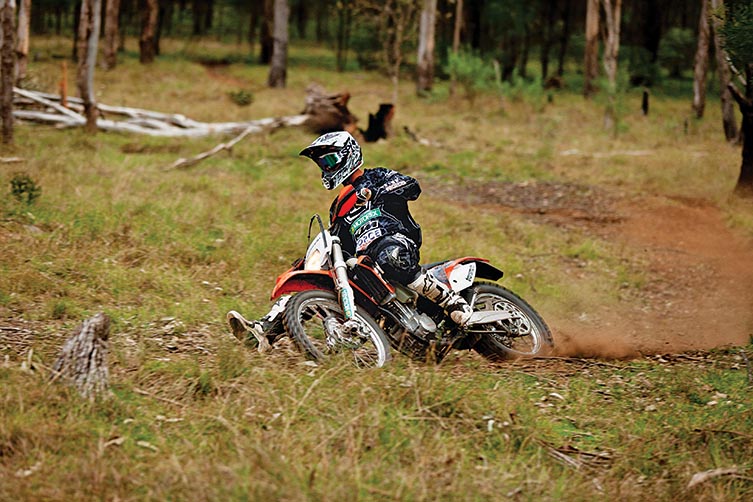
Lefts vs Rights
On a left-hand corner, the advantage is that you can stay on the rear brake longer on the corner entry to settle the bike, and then drag it around the whole corner if you need to. This is an advantage on rougher terrain or in sand where dragging the rear brake gives the rear-end a more planted feel. But the real benefit is on choppy exits, where dragging the rear brake can improve how the bike squats and drives. That said, brakes only slow you down. So, unless there’s a real benefit in using them, you’re better off focusing on line selection and smooth application of the throttle to maximise your corner speed.

Linking Turns
When you need to link a series of turns, staying smooth and drawing precise, clean lines are even more important – because, if you get out of shape on one turn, it’ll affect your entry and corner speed around the next one. The key thing when linking turns is to figure out which turn(s) you need to compromise some time through, in order to gain more back in the following one. For example, it’s worth giving up some exit speed on a turn if that allows you to cut inside some bad square-edged bumps or to set yourself up better for a turn that leads onto a long straight. For racers, this is where walking the track pays dividends. For trailriders on unknown tracks, it’s simply a matter of forcing yourself to look further ahead. In this sequence, you can see how I’ve stayed inside on the exit to the right-hander as it has given me a better, sweeping line into the next left. I’ve also used the rear brake to kick the rear-end out a bit and set up for the left-hander, but I’ve done it all in one smooth motion.
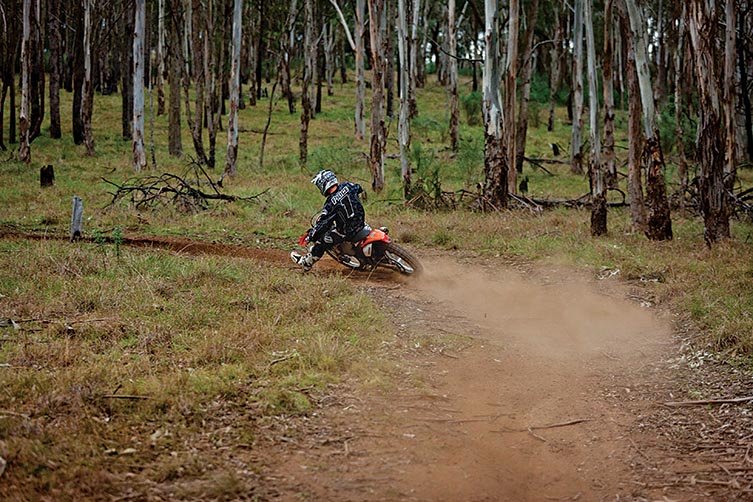
Control Use
Through some turns, I use a little pressure on the front brake up to the apex as this puts more weight on the front wheel, which squats the fork a little and prevents the bike from climbing out of a rut. And, although I run a finger on the clutch as a precaution, I tend to use very little clutch around turns, as midcorner clutch use can easily unsettle the bike’s balance and flow. With a smaller capacity bike, you might use a bit more clutch, but only a quick flick on the exit if and when you need to get the bike to stand up a bit quicker or to loft the front wheel to clear a tree root. The amount of clutch use all depends on where the corner’s apex is relative to the exit.
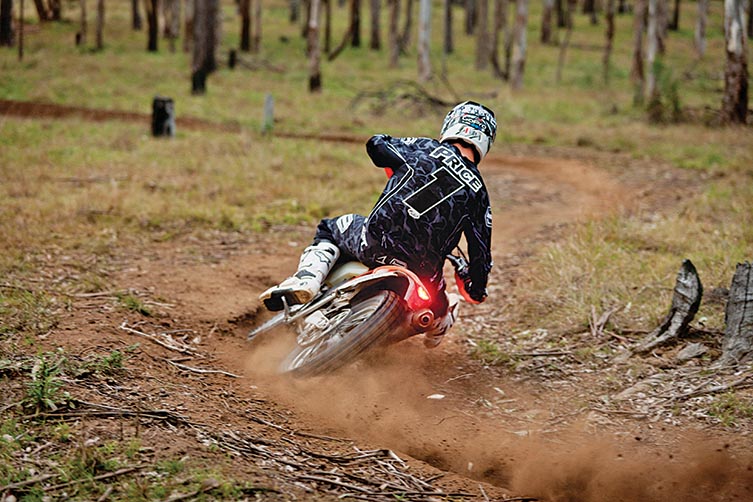
Sand Technique
You see a lot of guys throw their bike into sandy berms and bury the things. It might look good, but it causes the bike to bog – meaning you have to shift down to get the bike back on the revs. In other words, all it does is cost them valuable corner speed. In sand or loamy conditions, remember that the terrain itself is going to slow the bike down, and you’ll be using less front brake or it’ll want to tuck. I look to brake and set myself up a fraction earlier in sand, because my focus is on getting on the power much earlier than normal. Powering all the way through a softer type of turn keeps the front-end light and stops it from biting or tucking. You’re steering more with the rear-end, so you can afford to be a little more aggressive with the throttle and clutch, and you sit more central on the seat. And in sand, it’s important to keep the bike in the torquey part of the mid-range. If you rev it too hard, it’ll just dig a trench and go absolutely nowhere.
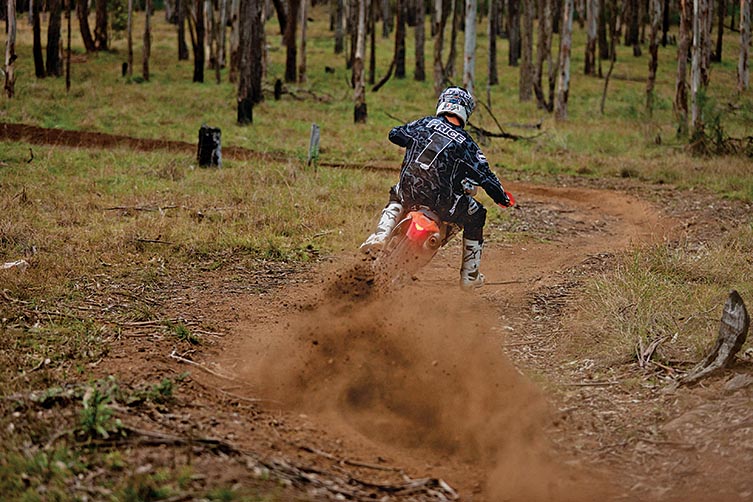
In The Mud
In muddy conditions when there’s very little grip on offer, everything has to be silky smooth. You’ll tend to come into the corner a little slower – using more engine braking than normal – and hunt for the best rut to lock into. In deep ruts, there’s no prizes for looking pretty, so don’t be afraid to get your legs off the pegs and do whatever it takes to keep your momentum up. On flat turns, you can’t crank the bike over as far in mud, so you have to keep the bike more upright. For traction, I look for grass on the edge of the track and I focus on short-shifting the motor and staying low in the revs so I can dial the power on like a tractor. You have to be patient with the throttle – it’s a case of going slower to go faster.

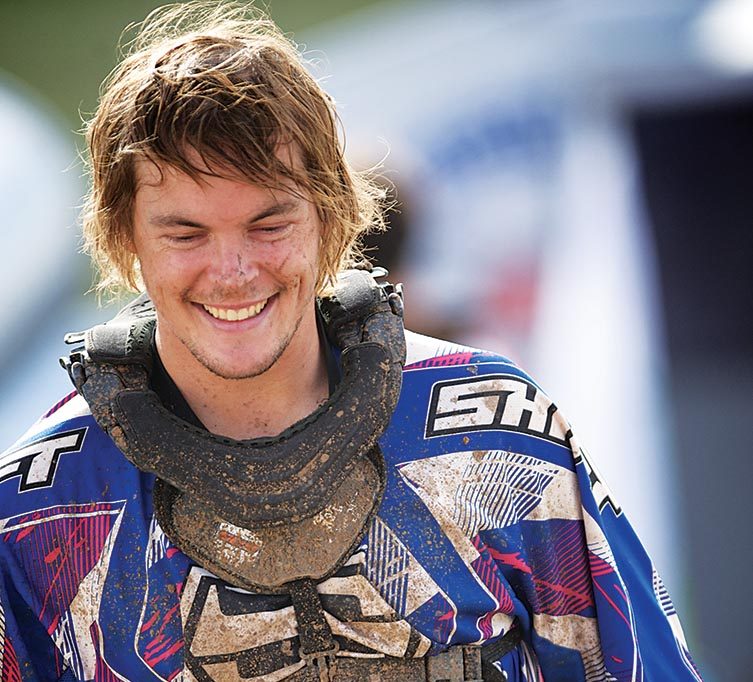
After winning the Outright AORC title at his first attempt in 2009, Toby Price joined the Motorex KTM Off-Road team for 2010 and dominated everything he entered. He defended his AORC crown in 2010, won his first Outright at the A4DE, and then won both the Finke and Hattah Desert Races. This year, he won the Hattah and the A4DE for a second time, before injuries sidelined him for the remainder of the season. So the lad from Singleton knows a thing or two about corner speed. Thankfully, he’s happy to share the wisdom with you.
Related Content
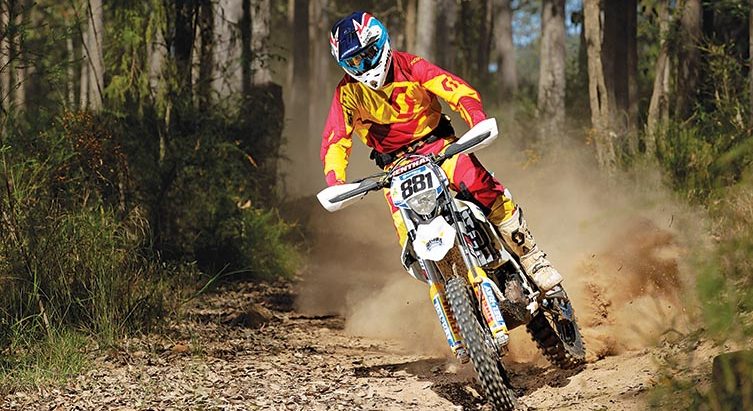
HOW TO: BRAKING & CORNER ENTRY

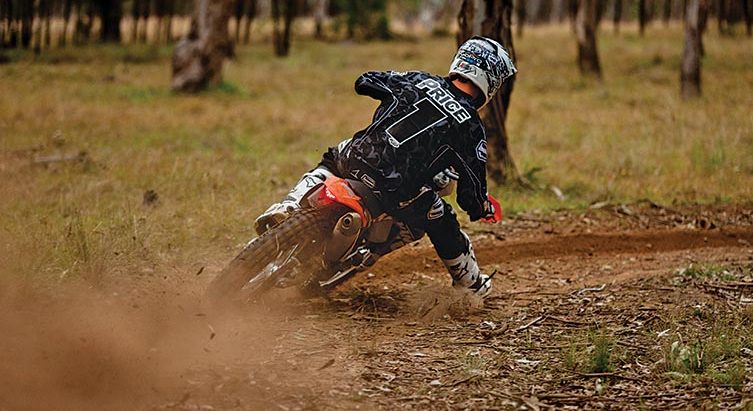







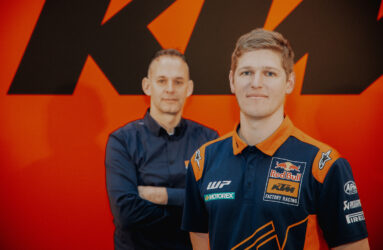
Be the first to comment...